1998 CHEVROLET MALIBU brake light
[x] Cancel search: brake lightPage 160 of 362
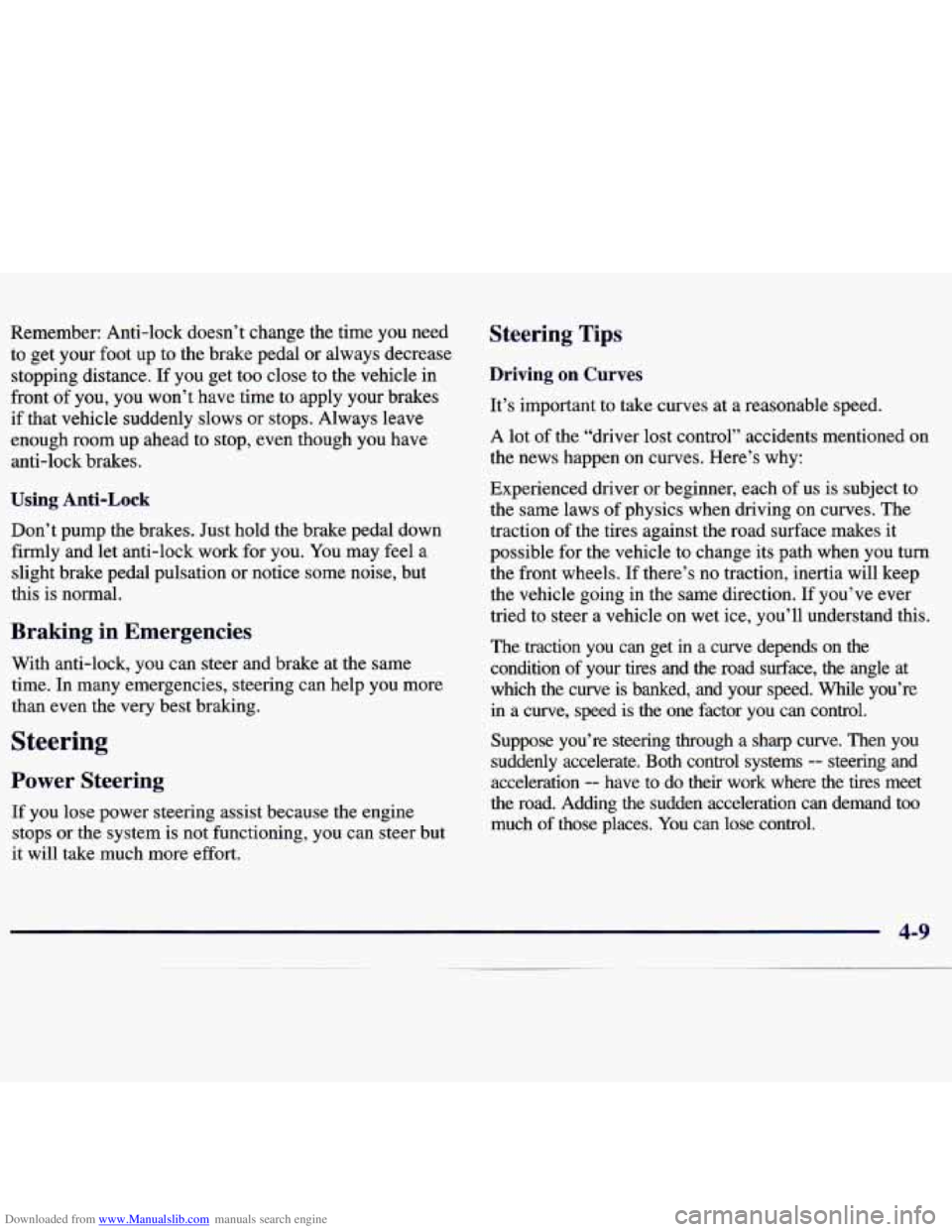
Downloaded from www.Manualslib.com manuals search engine Remember: Anti-lock doesn’t change the time you need
to get your foot up to the brake pedal or always decrease
stopping distance.
If you get too close to the vehicle in
front of you, you won’t have time to apply your brakes
if that vehicle suddenly slows or stops. Always leave
enough room up ahead to stop, even though you have
anti-lock brakes.
Using Anti-Lock
Don’t pump the brakes. Just hold the brake pedal down
firmly and let anti-lock work for you. You may feel a
slight brake pedal pulsation or notice some noise, but
this is normal.
Braking in Emergencies
With anti-lock, you can steer and brake at the same
time. In many emergencies, steering can help you more
than even the very best braking.
Steering
Power Steering
If you lose power steering assist because the engine
stops or the system is not functioning, you can steer but
it will take much more effort.
Steering Tips
Driving on Curves
It’s important to take curves at a reasonable speed.
A lot of the “driver lost control” accidents mentioned on
the news happen
on curves. Here’s why:
Experienced driver or beginner, each of
us is subject to
the same laws of physics when driving on curves. The
traction of the tires against the road surface makes it
possible for the vehicle to change its path when you turn
the front wheels. If there’s no traction, inertia will keep
the vehicle going in the same direction. If you’ve ever
tried to steer a vehicle on wet ice, you’ll understand this\
.
The traction you can get in a curve depends on the
condition of your tires and the road surface, the angle at
which the curve is banked, and your speed.
While you’re
in
a curve, speed is the one factor you can control.
Suppose you’re steering through a sharp curve. Then you
suddenly accelerate. Both control systems
-- steering and
acceleration
-- have to do their work where the tires meet
the road. Adding the sudden acceleration can demand too
much of those places.
You can lose control.
4-9
Page 168 of 362
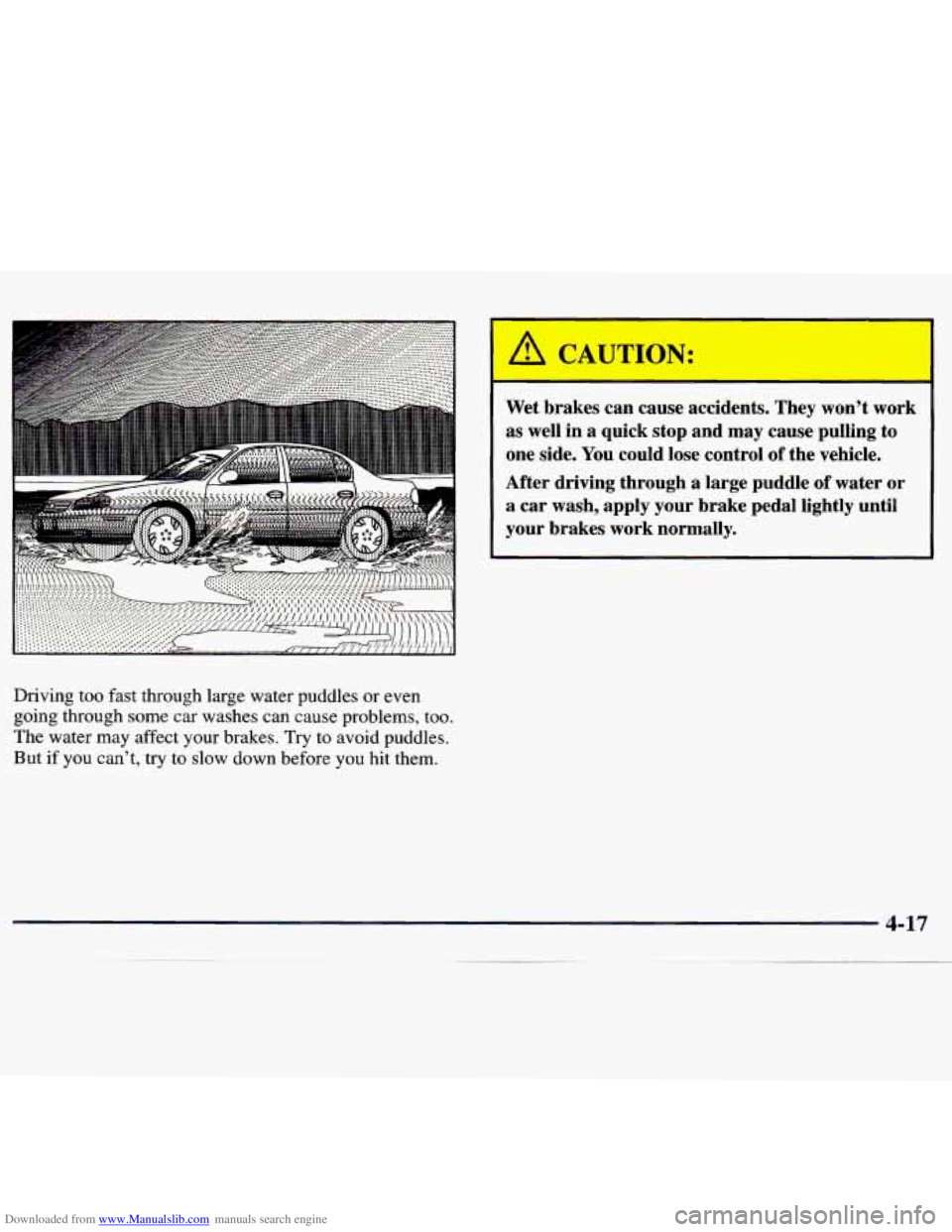
Downloaded from www.Manualslib.com manuals search engine Driving too fast through large water puddles or even
going through
some car washes can cause problems, too.
The water may affect your brakes. Try to avoid puddles.
But
if you can’t, try to slow down before you hit them.
4-17
I
Wet brakes can cause accidents. They won’t work
as well in a quick stop and may cause pulling to
one side. You could lose control
of the vehicle.
After driving through a large puddle
of water or
a car wash, apply your brake pedal lightly until
your brakes work normally.
Page 179 of 362
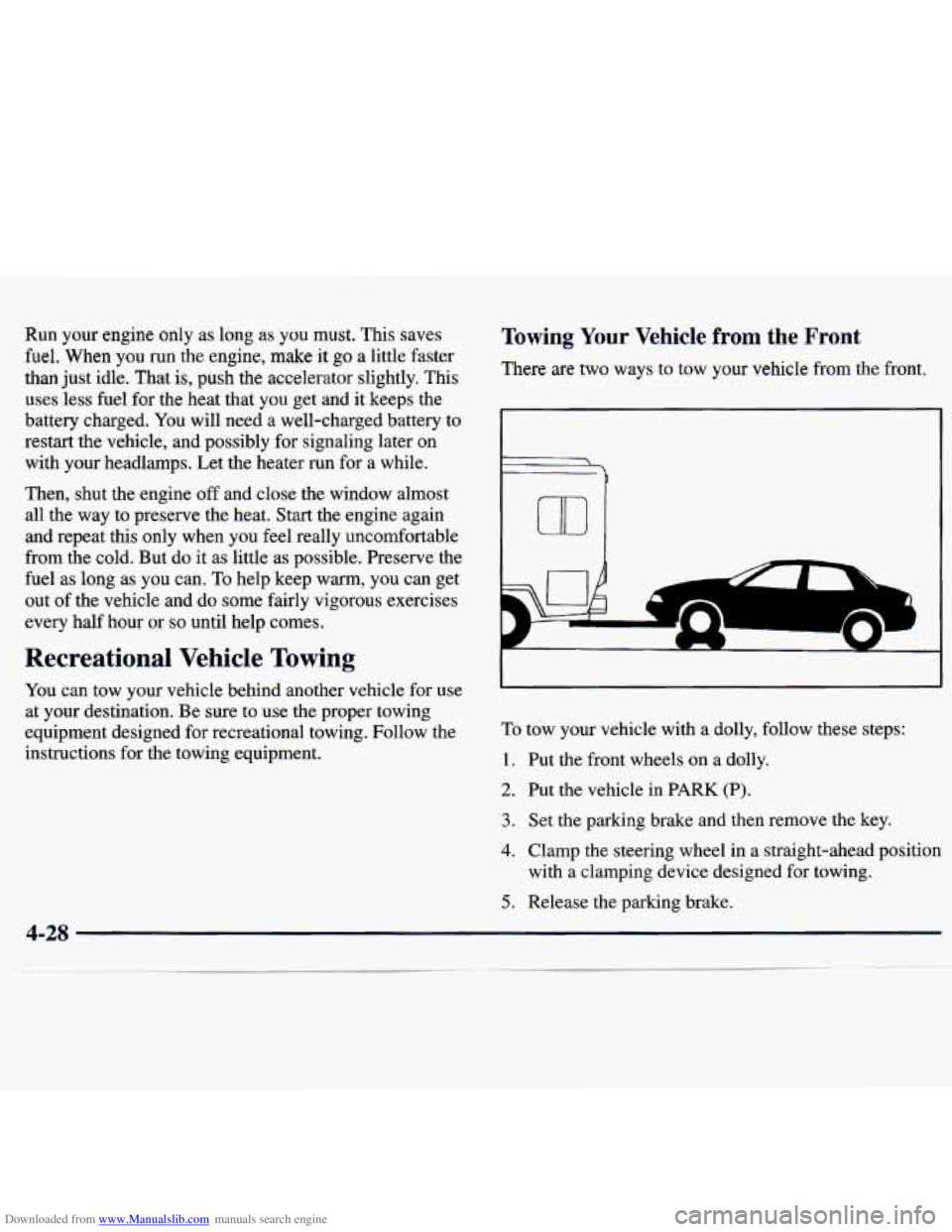
Downloaded from www.Manualslib.com manuals search engine Run your engine only as long as you must. This saves
fuel. When you
run the engine, make it go a little faster
than just idle. That
is, push the accelerator slightly. This
uses less fuel for the heat that you get and it keeps the
battery charged. You will need a well-charged battery to
restart the vehicle, and possibly for signaling later on
with your headlamps. Let the heater run for a while.
Then, shut the engine
off and close the window almost
all the way to preserve the heat. Start the engine again
and repeat this only when you feel really uncomfortable
from the cold. But do it as little as possible. Preserve the
fuel
as long as you can. To help keep warm, you can get
out of the vehicle and do some fairly vigorous exercises
every half hour or
so until help comes.
Recreational Vehicle Towing
You can tow your vehicle behind another vehicle for use
at your destination. Be sure to use the proper towing
equipment designed for recreational towing. Follow the
instructions for the towing equipment.
Towing Your Vehicle from the Front
There are two ways to tow your vehicle from the front,
To tow your vehicle with a dolly, follow these steps:
1. Put the front wheels on a dolly.
2. Put the vehicle in PARK (P).
3. Set the parking brake and then remove the key.
4. Clamp the steering wheel in a straight-ahead position
with
a clamping device designed for towing.
5. Release the parking brake.
Page 195 of 362
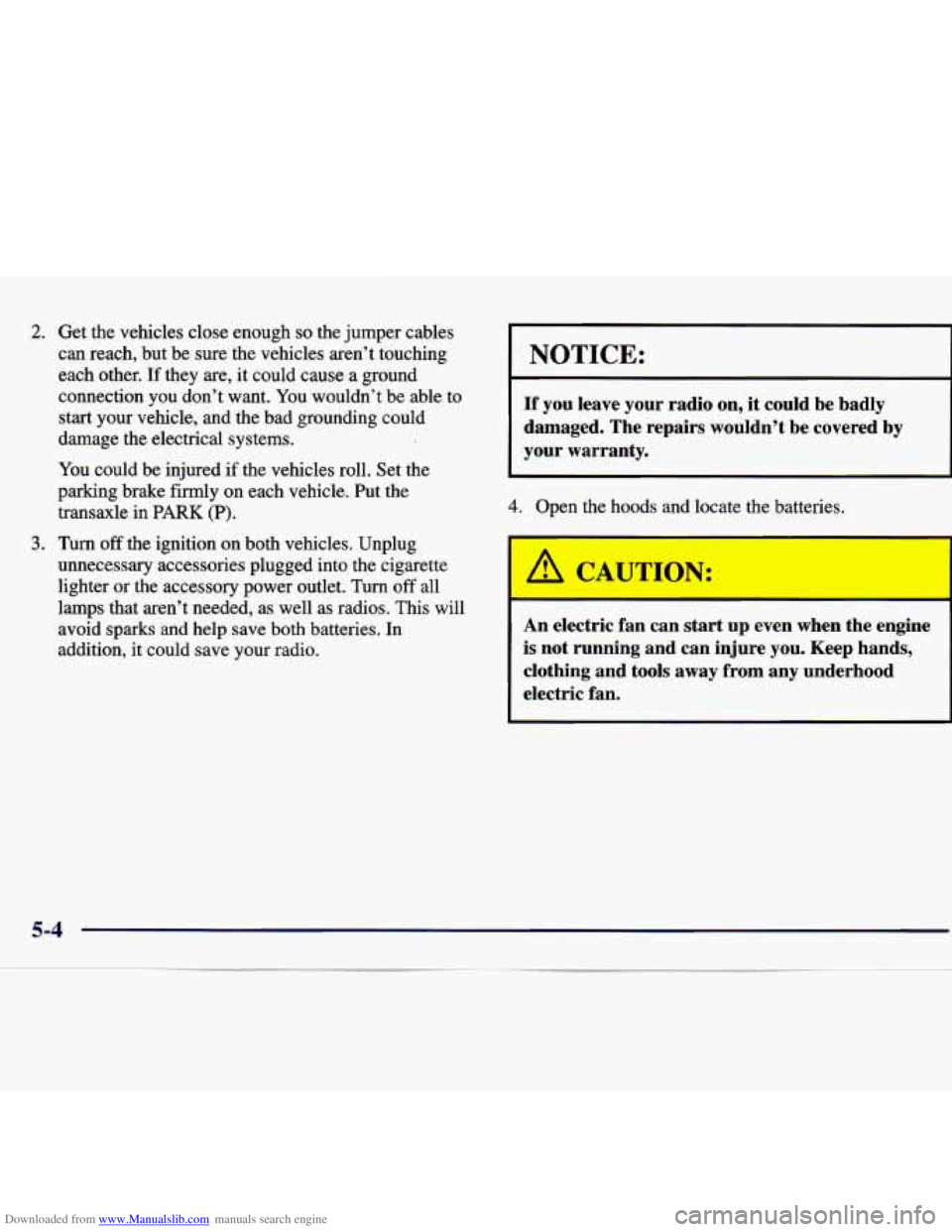
Downloaded from www.Manualslib.com manuals search engine 2. Get the vehicles close enough so the jumper cables
can reach, but be sure the vehicles aren’t touching
each other.
If they are, it could cause a ground
connection you don’t want.
You wouldn’t be able to
start your vehicle, and the bad grounding could
damage the electrical systems.
You could be injured if the vehicles roll. Set the
parking brake firmly on each vehicle. Put the
transaxle in
PARK (P).
unnecessary accessories plugged into the cigarette
lighter or
the accessory power outlet. Turn off all
lamps that aren’t needed, as well as radios. This will
avoid
sparks and help save both batteries. In
addition, it could save your radio.
3. Turn off the ignition on both vehicles. Unplug
I NOTICE:
If you leave your radio on, it could be badly
damaged. The repairs wouldn’t be covered by
your warranty.
4. Open the hoods and locate the batteries.
I
I A CAUTION:
An electric fan can start up even when the engine
is not running and can injure you. Keep hands,
clothing and tools away from any underhood
electric fan.
5-4
Page 252 of 362
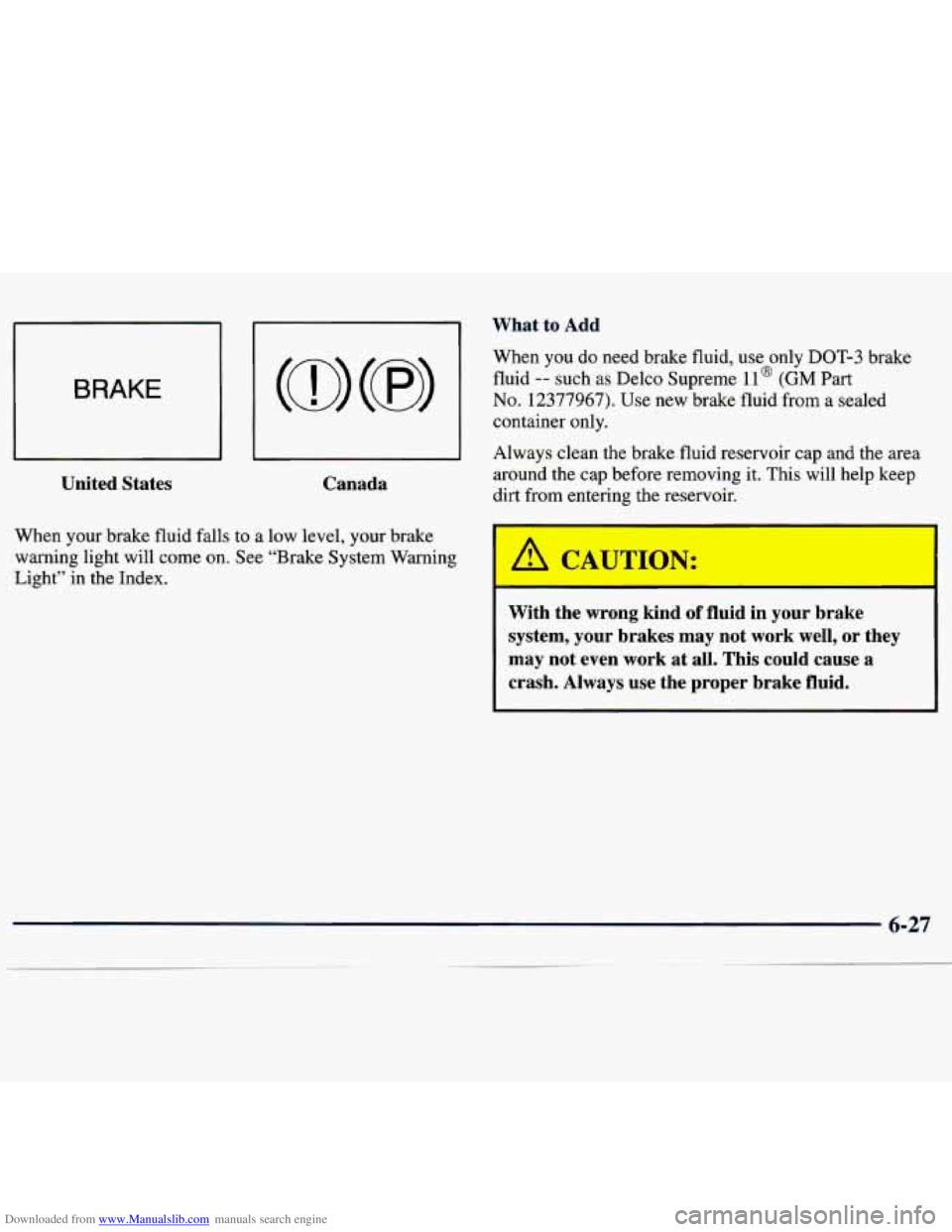
Downloaded from www.Manualslib.com manuals search engine BRAKE
United States Canada
When your brake fluid falls to a low level, your brake
warning light will come on. See “Brake System Warning
Light” in the Index.
What to Add
When you do need brake fluid, use only DOT-3 brake
fluid
-- such as Delco Supreme 11 @ (GM Part
No. 12377967). Use new brake fluid from a sealed
container only.
Always clean the brake fluid reservoir cap
and the area
around the cap before removing
it. This will help keep
dirt from entering the reservoir.
A CAJTION:
With the wrong kind of fluid in your brake
system, your brakes may not work well, or they
may not even work at all. This could cause a
crash. Always
use the proper brake fluid.
6-27
Page 254 of 362
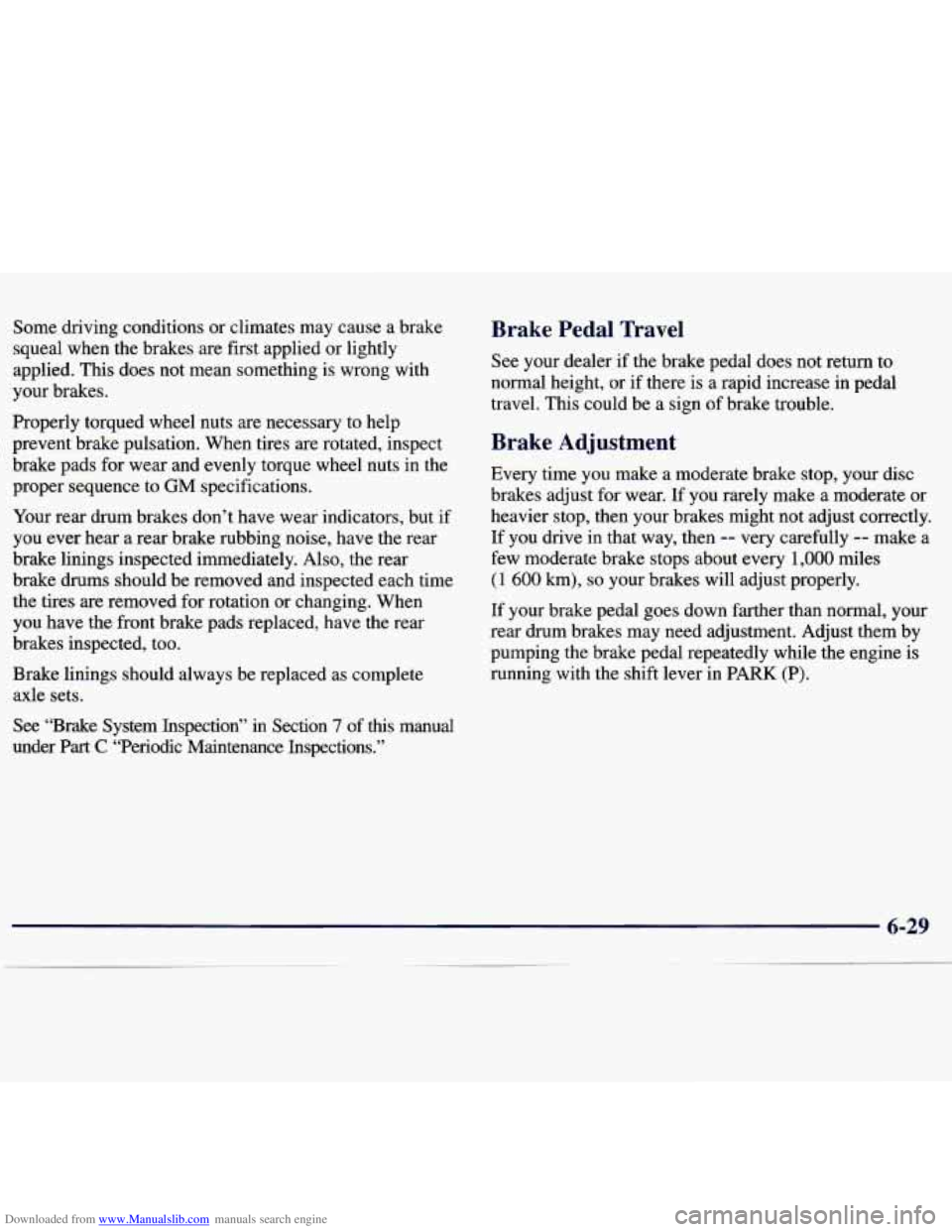
Downloaded from www.Manualslib.com manuals search engine Some driving conditions or climates may cause a brake
squeal when the brakes
are first applied or lightly
applied. This does not mean something is wrong with
your brakes.
Properly torqued wheel nuts are necessary to help
I prevent brake pulsation. When tires are rotated, inspect
brake pads for wear and evenly torque wheel nuts in the
proper sequence to GM specifications.
Your rear drum brakes don’t have wear indicators, but if
you ever hear a rear brake rubbing noise, have the rear
brake linings inspected immediately. Also, the rear
brake drums should be removed and inspected each time
the tires are removed for rotation or changing. When
you have the front brake pads replaced, have the rear
brakes inspected, too.
Brake linings should always be replaced as complete
axle sets.
Brake Pedal Travel
See your dealer if the brake pedal does not return to
normal height, or if there is a rapid increase in pedal
travel. This could be a sign of brake trouble.
Brake Adjustment
Every time you make a moderate brake stop, your disc
brakes adjust for wear.
If you rarely make a moderate or
heavier stop, then your brakes might not adjust correctly.
If you drive in that way, then
-- very carefully -- make a
few moderate brake stops about every
1,000 miles
(1 600 km), so your brakes will adjust properly.
If your brake pedal goes down farther than normal, your
rear drum brakes may need adjustment. Adjust them by
pumping the brake pedal repeatedly while the engine is
running with the shift lever in PARK
(P).
See “Brake System Inspection” in Section 7 of this manual
under Part
C “Periodic Maintenance Inspections.”
6-29
--
Page 285 of 362

Downloaded from www.Manualslib.com manuals search engine Fuse
4)
Usage
Right Hand Electrical Center-Fog
Lamps, Radio, Body Function Control
Module, Interior Lamps
Ignition Switch
Not Used
Anti-Lock Brakes
Cooling Fans
Mini-Relays
9) Rear Defog
10) Not Used
11) Anti-Lock Brakes
12) Cooling Fan
13) HVAC Blower (Climate Control)
14) Cooling Fans
15) Cooling Fans
16) Air Conditioning Compressor
17) Not Used
1% Fuel Pump
19) Automatic Light Control
Micro-Relays
Fuse
20)
21)
22)
Mini-Fuses
23
- 32)
33)
34)
35)
36)
37)
43)
44)
Usage
Automatic Light Control
Horn
Daytime Running
Lamps
Spare Fuse Holder
Rear Defog
Accessory Power Outlets, Cigar
Lighter
Anti-Lock Brakes
Anti-Lock Brakes
Air Conditioning Compressor, Body
Function Control Module
Automatic Transaxle
Powertrain Control Module, Ignition Anti-Lock Brakes
Ignition System Back-up Lamps, Brake Transaxle
Shift Interlock
Horn
Powertrain Control Module
Page 346 of 362
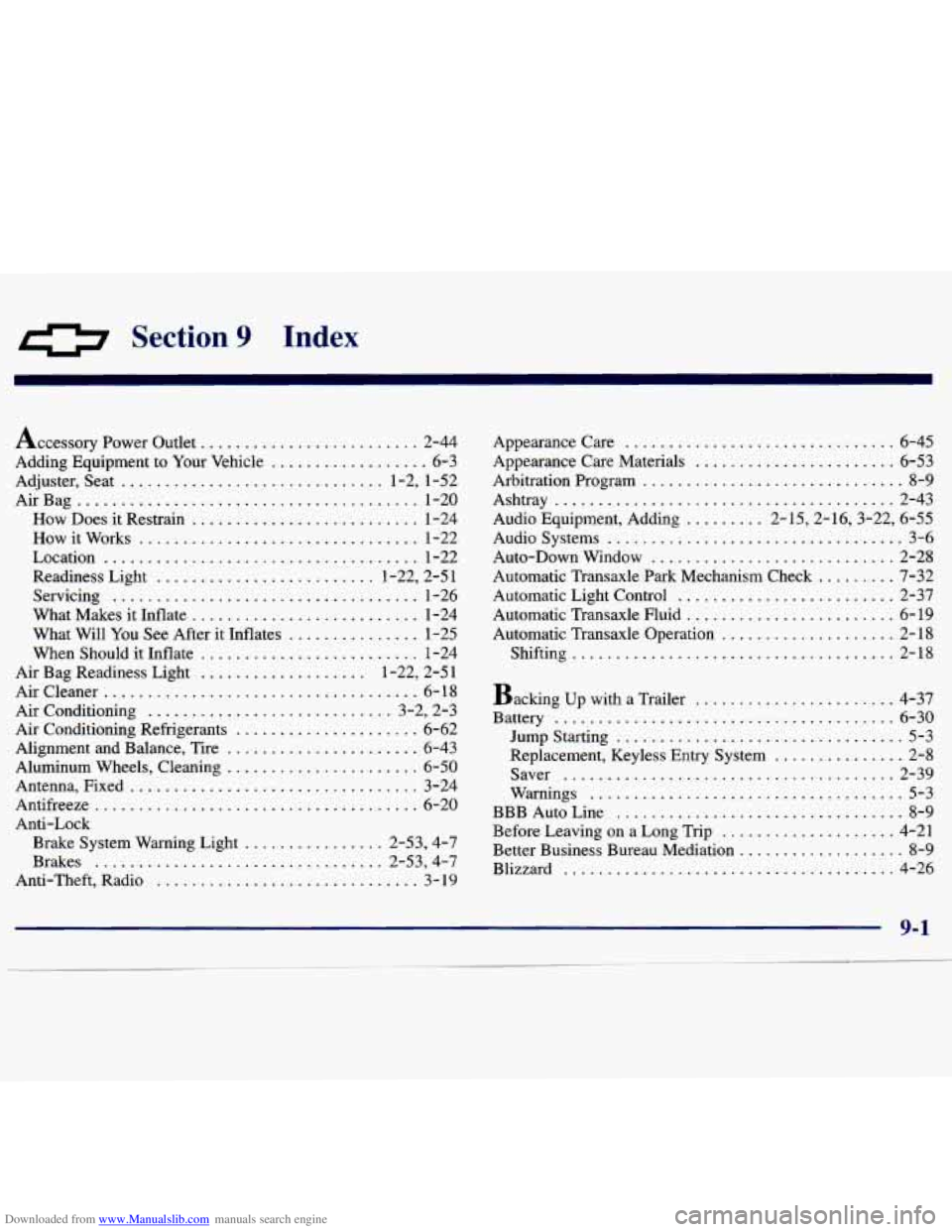
Downloaded from www.Manualslib.com manuals search engine 0 Section 9 Index
Accessory Power Outlet ......................... 2-44
Adding Equipment to Your Vehicle
.................. 6-3
Adjuster. Seat .............................. 1.2. 1.52
AirBag
....................................... 1-20
How Does it Restrain
.......................... 1-24
Howitworks
................................ 1-22
Location
.................................... 1-22
Readiness Light
......................... 1.22. 2.5 1
Servicing ................................... 1-26
What Makes it Inflate
.......................... 1-24
What Will
You See After it Inflates ............... 1-25
When Should it Inflate ......................... 1-24
Air Bag Readiness Light
................... 1.22. 2.5 1
Aircleaner .................................... 6-18
Air Conditioning ............................ 3.2. 2.3
Air Conditioning Refrigerants ..................... 6-62
Alignment and Balance. Tire
...................... 6-43
Aluminum Wheels. Cleaning
...................... 6-50
Antenna. Fixed ................................. 3-24
Antifreeze
..................................... 6-20
Anti-Lock
Brake System Warning Light
................ 2.53. 4.7
Brakes
................................. 2.53. 4.7
Anti.Theft. Radio .............................. 3- 19 Appearancecare
............................... 6-45
Appearance Care Materials
....................... 6-53
Arbitration Program
.............................. 8-9
Audio Equipment. Adding
......... 2.15.2.16.3.22. 6.55
Audio Systems .................................. 3-6
Auto-Down Window
............................ 2-28
Automatic Transaxle Park Mechanism Check
......... 7-32
Automatic Light Control
......................... 2-37
Automatic Transaxle Fluid
........................ 6-19
Automatic Transaxle Operation
.................... 2-18
Shifting
..................................... 2-18
Ashtray
....................................... 2-43
Backing up with a Trailer
....................... 4-37
Battery
....................................... 6-30
Jump Starting ................................. 5-3
Replacement, Keyless Entry System ............... 2-8
Saver
...................................... 2-39
Warnings
.................................... 5-3
BBB Auto Line
................................. 8-9
Before Leaving on
a Long Trip .................... 4-21
Better Business Bureau Mediation
................... 8-9
Blizzard
...................................... 4-26
__.~ ... .......... ~- ~